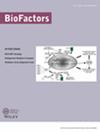橙花叔醇通过抑制 NLRP3 炎性体和调控 MAPK/AKT 通路,挽救糖尿病大鼠的海马损伤
摘要
尽管观察到糖尿病诱发脑组织损伤以及学习和记忆受损,但损伤的潜在机制仍然难以捉摸,也缺乏有效的靶向治疗药物。值得注意的是,NLRP3 炎性体在糖尿病患者的海马中高度表达。奈洛利多(Nerolidol)是一种天然化合物,具有抗炎和抗氧化特性,被认为是治疗代谢紊乱的潜在疗法。然而,橙花叔醇对糖尿病海马损伤的改善能力及其内在机制仍不清楚。研究人员利用网络药理学和分子对接技术预测了橙花醇治疗糖尿病的信号通路和治疗靶点。然后利用链脲佐菌素(STZ)结合高脂饮食建立了糖尿病大鼠模型,并给予橙花叔醇。莫里斯水迷宫评估空间学习记忆能力。采用苏木精、伊红和 Nissl 染色检测糖尿病海马的神经元损伤。透射电子显微镜用于检测线粒体、内质网(ER)和突触的损伤程度。免疫荧光用于检测海马中GFAP、IBA1和NLRP3的表达。用 Western 印迹法检测细胞凋亡(Bcl-2、BAX 和裂解-Caspase-3);突触(突触后致密化蛋白 95、SYN1 和突触素);线粒体(DRP1、OPA1、MFN1 和 MFN2);ER(GRP78、ATF6、CHOP 和 caspase-12);NLRP3炎性体(NLRP3、ASC和caspase-1)、炎性细胞因子(IL-18、IL-1β和TNF-α)、AKT(P-AKT)和丝裂原活化蛋白激酶(MAPK)通路(P-ERK、P-p38和P-JNK)相关蛋白的表达。网络药理学显示,橙花叔醇治疗糖尿病的可能机制是 MAPK/AKT 通路和抗炎作用。动物实验表明,橙花叔醇可以改善糖尿病大鼠的血糖、血脂和海马神经元损伤。此外,橙花叔醇还能通过影响突触、线粒体和ER相关蛋白,改善糖尿病大鼠海马超微结构中的突触、线粒体和ER损伤。进一步的研究发现,橙花叔醇可降低海马组织中的神经炎症、NLRP3和炎症因子的表达,同时还可降低MAPK通路的表达,增强AKT通路的表达。然而,奈洛多尔改善糖尿病大鼠海马损伤的作用并不能改善认知功能。总之,我们的研究首次揭示了橙花醇可以改善糖尿病大鼠的海马损伤、神经炎症、突触、ER和线粒体损伤。此外,我们还发现橙花叔醇可抑制NLRP3炎症小体,并影响MAPK和AKT的表达。这些发现为使用橙花叔醇改善糖尿病引起的脑组织损伤和相关疾病提供了新的实验依据。


Despite the observation of diabetes-induced brain tissue damage and impaired learning and memory, the underlying mechanism of damage remains elusive, and effective, targeted therapeutics are lacking. Notably, the NLRP3 inflammasome is highly expressed in the hippocampus of diabetic individuals. Nerolidol, a naturally occurring compound with anti-inflammatory and antioxidant properties, has been identified as a potential therapeutic option for metabolic disorders. However, the ameliorative capacity of nerolidol on diabetic hippocampal injury and its underlying mechanism remain unclear. Network pharmacology and molecular docking was used to predict the signaling pathways and therapeutic targets of nerolidol for the treatment of diabetes. Then established a diabetic rat model using streptozotocin (STZ) combined with a high-fat diet and nerolidol was administered. Morris water maze to assess spatial learning memory capacity. Hematoxylin and eosin and Nissl staining was used to detect neuronal damage in the diabetic hippocampus. Transmission electron microscopy was used to detect the extent of damage to mitochondria, endoplasmic reticulum (ER) and synapses. Immunofluorescence was used to detect GFAP, IBA1, and NLRP3 expression in the hippocampus. Western blot was used to detect apoptosis (Bcl-2, BAX, and Cleaved-Caspase-3); synapses (postsynaptic densifying protein 95, SYN1, and Synaptophysin); mitochondria (DRP1, OPA1, MFN1, and MFN2); ER (GRP78, ATF6, CHOP, and caspase-12); NLRP3 inflammasome (NLRP3, ASC, and caspase-1); inflammatory cytokines (IL-18, IL-1β, and TNF-α); AKT (P-AKT); and mitogen-activated protein kinase (MAPK) pathway (P-ERK, P-p38, and P-JNK) related protein expression. Network pharmacology showed that nerolidol's possible mechanisms for treating diabetes are the MAPK/AKT pathway and anti-inflammatory effects. Animal experiments demonstrated that nerolidol could improve blood glucose, blood lipids, and hippocampal neuronal damage in diabetic rats. Furthermore, nerolidol could improve synaptic, mitochondrial, and ER damage in the hippocampal ultrastructure of diabetic rats by potentially affecting synaptic, mitochondrial, and ER-related proteins. Further studies revealed that nerolidol decreased neuroinflammation, NLRP3 and inflammatory factor expression in hippocampal tissue while also decreasing MAPK pathway expression and enhancing AKT pathway expression. However, nerolidol improves hippocampal damage in diabetic rats cannot be shown to improve cognitive function. In conclusion, our study reveals for the first time that nerolidol can ameliorate hippocampal damage, neuroinflammation, synaptic, ER, and mitochondrial damage in diabetic rats. Furthermore, we suggest that nerolidol may inhibit NLRP3 inflammasome and affected the expression of MAPK and AKT. These findings provide a new experimental basis for the use of nerolidol to ameliorate diabetes-induced brain tissue damage and the associated disease.

 求助内容:
求助内容: 应助结果提醒方式:
应助结果提醒方式:


